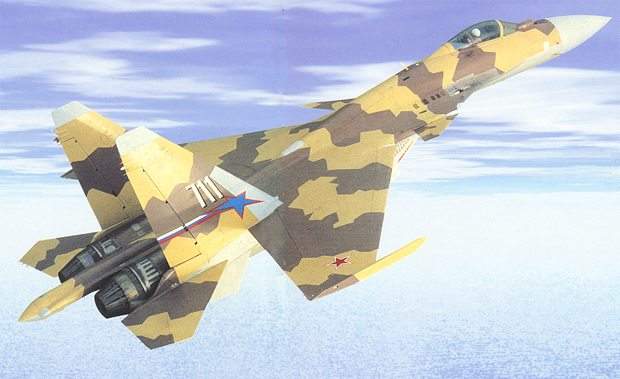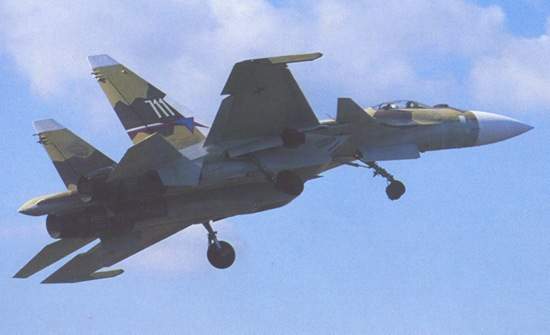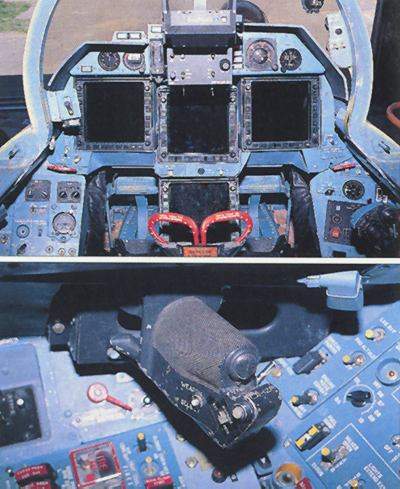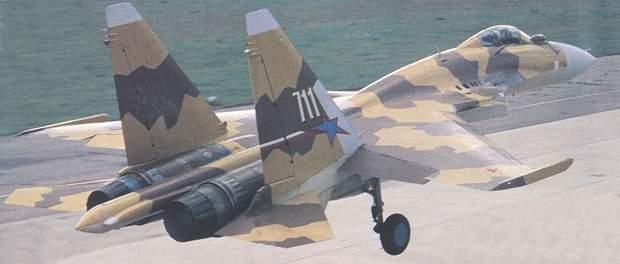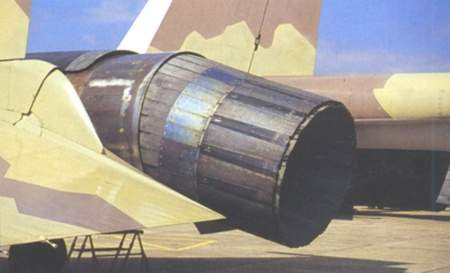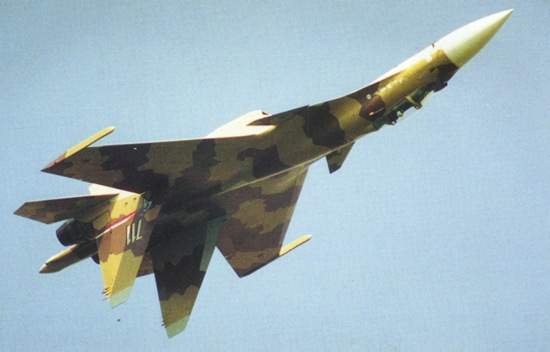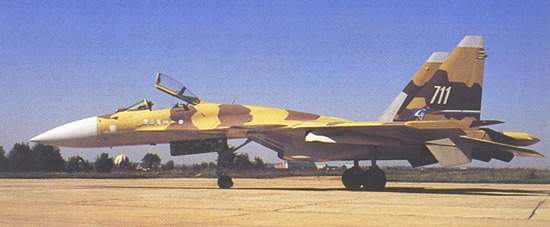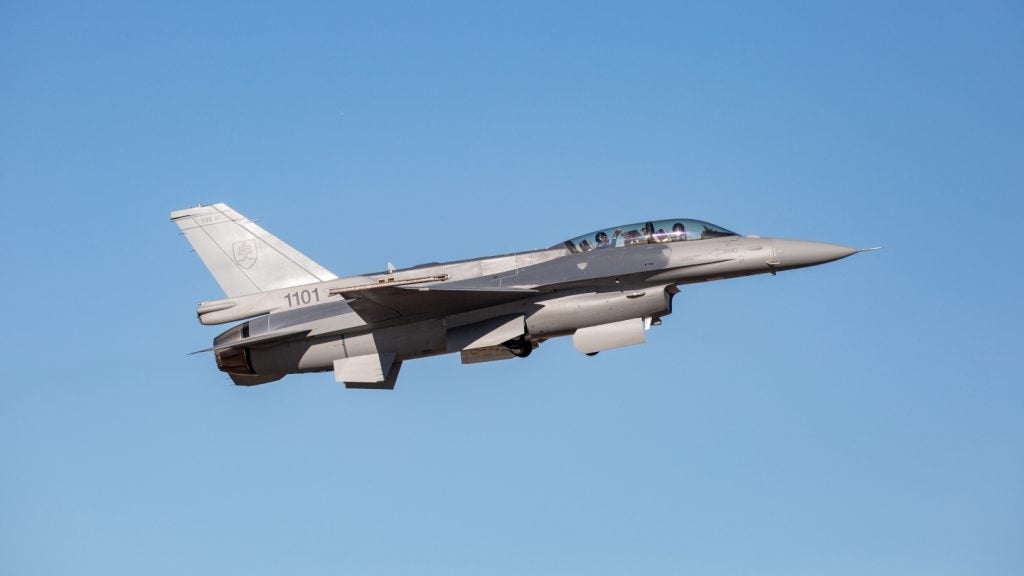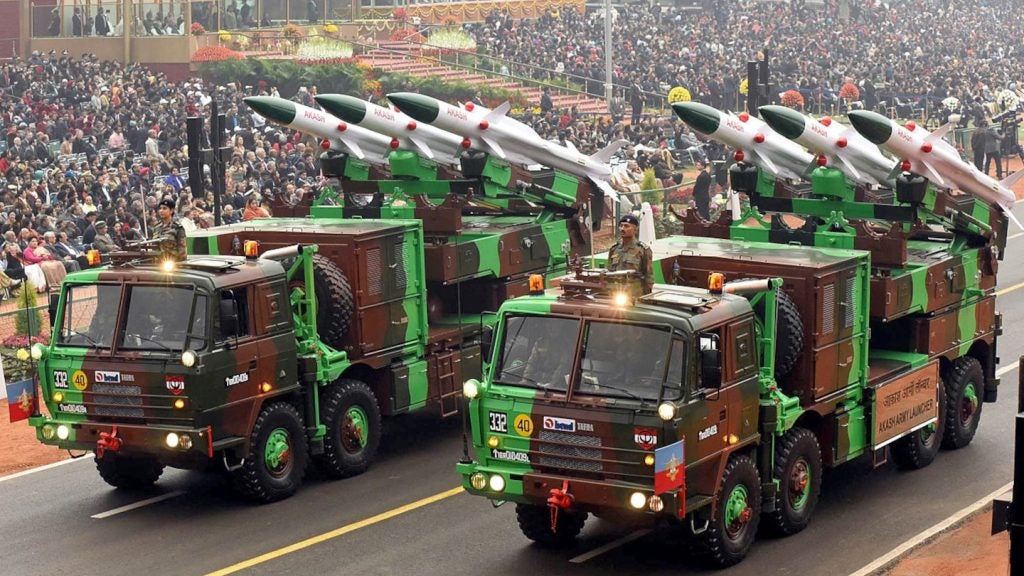The Su-37 multirole, all-weather fighter aircraft demonstrator is derived from the family of aircraft based on the Su-27, which was developed in 1977 by the Sukhoi Experimental Design Bureau in Moscow and is in service with the Russian Air Force and a number of other countries. This family also includes the Su-27UB, Su-30, Su-33, Su-32FN and Su-35, and has the Nato codename Flanker. The Russian Air Force is currently operating two Su-37 aircraft.
The new feature of the super-manoeuvrable Su-37 fighter is the two-dimensional thrust vector control engines, which allow the aircraft to recover from spins and stalls at almost any altitude, while it is also equipped with full digital fly-by-wire controls.
The first flight of the Su-37 prototype was in April 1996, with a public appearance at the Mosaero show. This was followed by a demonstration flight at the Farnborough 1996 Airshow.
The aircraft demonstrated new manoeuvres, such as the ability to point the nose away from direction of flight for sustained periods, rotating the nose through 360° and recovering from tail slide by rolling into an entirely different plane. State funding for the aircraft was withdrawn for a time, but restored in 1999. However in 2002 one of the two Su-37s crashed, effectively ending the programme. The Su-37 technology and modernisations did however make it into new Flanker variants such as the Su-35BM Flanker-E and the Su-30MKI Flanker-H.
Cockpit
The cockpit is fitted with four liquid crystal displays for tactical and navigation data, onboard system monitors, and operating conditions control panel. The pilot has a side short-travel control stick instead of a central stick, an avionics control handle and strain-gauging (pressure-to-throttle) engine thrust controls. Avionics for the aircraft were produced by Kronstadt, St Petersburg.
Weapons
The Su-37 can carry up to 14 air-to-air missiles and up to 8000kg of ordnance. The twelve external hardpoints can carry air-to-air missiles, air-to-surface missiles, bombs, rockets and an ECM (electronic countermeasures) pod. The aircraft is fitted with one GSh-301 30mm gun with a maximum rate of fire of 1,500 rounds a minute.
The aircraft can be equipped with Vympel R-73E short-range air-to-air missiles with infrared terminal homing and RVV-AE long-range air-to-air missiles with active radar guidance. R-73E (Nato codename AA-11 Archer) is an all-aspect, close-combat missile capable of engaging targets in tail-chase or head-on mode at altitudes between 0.02km and 20km, and target g-load to 12g. The Vympel RVV-AE (AA-12 Adder) air-to-air missile, also known as the RR-77, can intercept targets at speeds up to 3,600kph and altitudes from 0.02 to 25km.
The Su-37 can be fitted with air-to-surface missiles such as the Kh-25 (AS-12 Kegler) short-range missile and Kh-29 (AS-14 Kedge) with a 317kg penetrating warhead.
Sensors
The aircraft is fitted with a multifunction, forward-looking, NO-11M pulse Doppler phased array radar, which can track up to 15 targets simultaneously and provide target designation and guidance to air-to-air missiles. NO-11M is manufactured by NIIP, the Tikhomirov Scientific Research Institute of Instrument Design.
There is also a rear-looking NIIP NO-12 radar and optronic fire-control and surveillance system.
There are also systems for terrain-following and terrain-avoidance, mapping and multichannel employment of guided weapons.
Engines
The Su-37 is powered by two AL-31FU TVC (thrust vector control) turbofan engines. This engine was developed by the Lyulka Engine Design Bureau (NPO Saturn) and is a derivative of the AL-31F twin-shaft turbofan engine on the Su-27. The modular design includes a four-stage, low-pressure (LP) compressor; a nine-stage, high-pressure (HP) compressor; annular combustion chamber and single-stage LP and HP turbines, afterburner and mixer. Each engine provides 83.36kN thrust and 142kN with the afterburner and is steerable from -15° to +15° along the vertical plane.
The thrust vector control is fully integrated into the digital flight control system. The TVC nozzle can be deflected both synchronously and differentially, depending on manoeuvre. The nozzle is connected to the annular swivel and can be moved in the pitch plane by two pairs of hydraulic jacks. The thrust vector control allows manoeuvres at speeds nearing zero without angle-of-attack limitations. The vectoring controls can be operated manually by the pilot or automatically by the flight control system.
Performance
The Su-37 all-weather multirole fighter aircraft can fly at a maximum speed of 2,440km/h. The range and service ceiling of the aircraft are 3,700km and 18,000m respectively and the aircraft weighs around 18,500kg.

